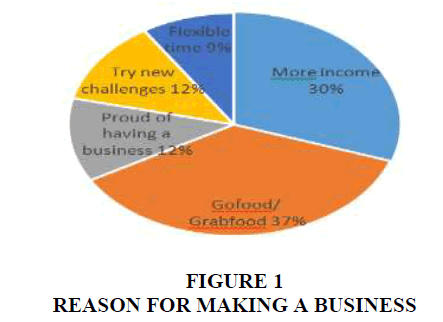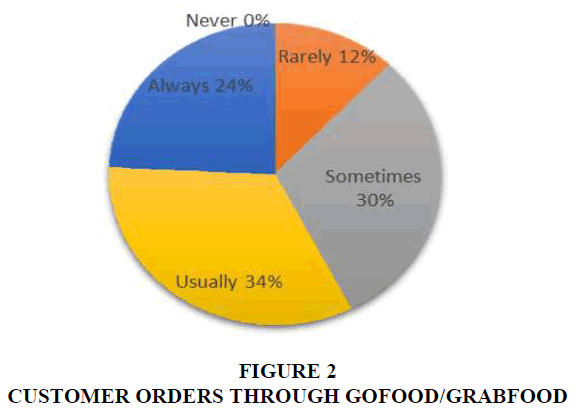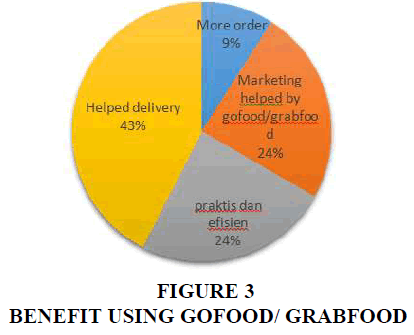Research Article: 2019 Vol: 23 Issue: 2
The Role of Technology in Increasing Motivation of Millennial Women Entrepreneurs Starting a Business in the Digital Era
Abstract
The development of entrepreneurship in Indonesia proves that entrepreneurship is one of the important aspects needed to improve the country's economy. The benefits of entrepreneurship are one of them to improve the standard of living and the economy of the community. Technological development greatly helped the development of entrepreneurs in Indonesia, especially in the culinary field. The presence of online delivery applications, namely Gofood and Grabfood has had a big impact on changes that initially bought food conventionally but now it can through the online delivery application. This research was using questionnaires and interviews with young women with 33 respondents aged 17-30 years old who has her own culinary business. The data was collected around five weeks and for data, analysis used Statistical Package for Social Sciences (SPSS) Software version 21 to analysis the data. Young women in the digital era were greatly helped by technological advancements. Delivery through Gofood and Grabfood makes it easy for consumers to buy food without having to go to the food restaurant. Simply use the application and select the food they want and will be delivered to their food and food and will be delivered to their location. Desire to open food business is currently there Gofood and Grabfood, so it is very helpful in expanding the reach of its customers, Gofood and Grabfood is a free application for business owners and very profitable in increasing sales.
Keywords
Motivation, Millennial, Women, Entrepreneurs, Technology
Introduction
To advance and maintain economic stability and development, a country have to a large numbers of entrepreneurs. Indonesia starting to show its teeth by showing a satisfying increase. Starting from 2011 with 750,399 inhabitants (0.24%), and then increasing to 3,707,205 residents (1.56%) in 2012 and 3.1% of the total population of Indonesia in 2018 (Rachmania et al., 2012). Although actually still classified low when compared to the standards of developed countries, where the population reaches 14% in entrepreneurship and when compared to neighbouring countries such as Singapore which reaches 7%, Malaysia 6%, and Thailand 5%. Indonesia at least has shown its seriousness and determination in improving its economic situation with implement various programs and promotions that support the level of entrepreneurs (Fauzi, 2017; Ambad & Damit, 2016).
According to Gilad & Levine (2005) there are two ratios associated with why someone chooses to become an entrepreneur. They call it the push theory and the pull theory. The push theory says that someone is motivated to entrepreneurship because of the factors of negative external impulses such as dissatisfaction with previous jobs, the difficulty of finding a job opening, insufficient salary or wages, or a work schedule that is not flexible. On the one hand, the pull theory refutes the push theory by arguing that the emergence of one's interest in entrepreneurship is due to the desire to seek freedom, wealth, self-fulfillment and much more.
As we know, the worldview of women is still considered one eye. Especially in Eastern countries such as Indonesia, if a woman successfully completes her education, they are required to become workers without pay as housewives. However, it cannot be denied that women also strongly encourage the growth of a country. It is evident that the number of female workers and entrepreneurs in Indonesia has increased significantly since the eighties. And after the economic crisis of 1997/98, the development of women's entrepreneurial interests began to emerge. At present, the number of female entrepreneurs in Indonesia is 14.3 million. This number increased by 1.6 million from the previous number, which only amounted to 12.7 million people. According to an international journal on gender and a women's study in 2017 explained that there are at least three reasons why there is interest in women's entrepreneurship. First because the number of female entrepreneurs continues to increase each year, and most of them are in micro and small companies. Meanwhile, there are only a few large women entrepreneurs. As the number continues to grow, Indonesian women entrepreneurs are considered as a new motor in economic growth to improve the welfare of the Indonesian people. Second, Indonesia is incorporated in the UNinitiated Millennium Development Goals (MDGs) which ended in 2015 (Pahuja, 2015) (and continued with the Millennium Sustainable Goals (MSG)) where women's empowerment is one of its goals, and the Indonesian government realizes that women's entrepreneurship is very important in achieving that goal. And third because poverty is still one of the big problems in Indonesia, with the presence of business owners or entrepreneurs it will have a significant effect on poverty reduction itself (Tambunan, 2017).
The advancement of technology helps facilitate entrepreneurship activities, the existence of gojek and grab as a delivery service company facilitates business activities so that women can do business at home
Literature Review
Entrepreneurship
Entrepreneurship is a concept of creating new products, markets and distribution systems (Anne et al., 2006). Another opinion defines entrepreneurship is someone who has the expertise to exploit opportunities and introduce them in a better way (Shane, 2003; Ambrish, 2104)
The importance of a development of entrepreneurship and small and medium enterprises is seen quite clearly in reality for the needs of a country's long-term economic development. For example, in European countries or more commonly known as U-27s, it accounts for 99.8% of entrepreneurial activities, where the majority are micro business activities, which reach 91.8% of the total existing businesses. Do not stop there, this small and medium business is able to offer job vacancies to 67.1% of the total existing employees (Schmiemann, 2008). Entrepreneurship certainly also helps the community to improve their living standards, by creating various types of innovative products and services that have never existed before to meet people's needs. In addition, entrepreneurship also helps the community to sharpen their identification skills and managerial abilities, which later can be used to create new technologies and create a product with better quality.
Women’s Motivation Starting a Business
The existence of someone's intention to entrepreneurship shows their desire to become an entrepreneur to be cultivated as their career. People who have the intention of entrepreneurship will plan to take calculated risks, collect the resources needed to start their businesses and establish their own businesses independently. Bird (1992) revealed that an intention has the same meaning as a freedom and a desire. He also added that an intention is a person's emotional condition that directs thoughts, attention, experiments and actions towards the goals to be achieved.
Carsrud & Brannback (2011); Stefanovic et al. (2011) state that motivation is a link between entrepreneurial intentions and concrete actions for entrepreneurship, which gives rise to a relationship between motivation and actual implementation (Herron & Robinson, 1993; Kuratko et al., 1997). Kuratko, Hornsby & Nafziger (1997) stated that to understand the process of entrepreneurship, one must identify and find out the motivation of entrepreneurs starting a business. Various external and internal factors that have encouraged entrepreneurs to start businesses have also been found (Kuratko et al., 1997; Robichaud et al., 2001).
Kuratko et al., (1997) classify the motivation of someone to become an entrepreneur into 4 categories: finance, recognition, freedom and family tradition (motivating you to continue your family business). Ruyat (1993) shows that entrepreneurial motivation can be equated with the willingness of entrepreneurship. Fayolle (2000) explains that an intention is someone's desire to produce an action. The desire to obtain freedom or often referred to as autonomy, family welfare, fulfilment of self-satisfaction and development, financial gain, and getting recognition are some factors that encourage a person to involve themselves in entrepreneurial activities (Chu et al., 2007).
Benzing et al., (2009), in his research on entrepreneurship in Turkey, presents some of the results of comparisons obtained from a number of studies conducted on entrepreneurial motivation in several different countries. For example, they say that in Swierczek & Ha's (2003) study of entrepreneurial motivation of small business owners in Vietnam, it was found that rewards and challenges were the main motivations that encouraged them to become entrepreneurs compared to fulfilling personal satisfaction and fulfilling well-being.
In Romania, the need to earn income and job security is the main factor that drives them to become entrepreneurs compared to fulfilling self-satisfaction and personal needs (Benzing et al., 2005). While entrepreneurs in India are driven to entrepreneurship because of the willingness to have freedom and to increase their income (Benzing & Chu 2005; Segal et al., 2005). In Turkey, entrepreneurs are encouraged to become entrepreneurs because of the desire to create prosperity for themselves and their families, and to increase income (Ozsoy et al., 2001). Benzing et al., (2009) also present the results of their research conducted in African countries.
Entrepreneurs in Uganda are encouraged to become entrepreneurs to make money (Bewayo, 1995). A study of entrepreneurs in Kenya & Ghana (Chu et al., 2007), found that one of the biggest two motivations for entrepreneurship is to increase income and create jobs for themselves. Roy and Wheeler (2006) also found that small business owners in West Africa were encouraged to become entrepreneurs because of the desire to fulfill their psychological needs, such as food and shelter.
Krueger et al. (2000) believe that with consideration there will be an intention. He (2000) also added that motivation for entrepreneurship is the most important process for explaining entrepreneurship. Autio et al. (1997) examined the trial of Davidsson (1995) which states that economic and psychological factors also influence students' entrepreneurial motivation. Brockhaus (1982); Robinson et al. (1991) states that theoretically and conceptually, actions and entrepreneurial behaviour are better approaches used to study entrepreneurial motivation compared to personality, environment and demographic conditions because more behaviorspecific rather than characteristic-specific (Gaddam, 2008).
In addition, the educational support received has also been known as a determinant of the intention of entrepreneurship. A study conducted in several students in Turkey found that the education presented in college had a positive impact on the emergence of a desire for entrepreneurship (Türker & Selçuk, 2009). This kind of research was also held in Malaysia and it was found that the correct explanation of entrepreneurship would influence the students' intention to become entrepreneurs (Mumtaz et al., 2012). In Indonesia itself, after conducting several studies, it was found that someone has the intention to entrepreneurship driven by high income factors, flexible working hours and family welfare. The results of these studies also have similarities with research conducted on Lebanese entrepreneurs regarding their entrepreneurial motivation, that someone motivated to entrepreneurship is driven by the desire to be free, flexible working hours, family welfare and high income (Fahed-Sreih et al., 2009)
Methods
This research was realized in Indonesia uses questionnaires and interviews with young women entrepreneurs with 33 respondents with aged between 17-30 years old who has her own business. The data was collected around five weeks and for data, analysis used Statistical Package for the Social Sciences (SPSS) Software version 21 to analysis the data.
Results
Demography
All respondents in this study were young women who owned businesses with 33 respondents. The age of respondents less than 20 years is as many as 2 people, 21-25 years as many as 19 people, 26-30 years as many as 12 people, and all culinary efforts in the city of Semarang. All respondents have been registered as gofood/grabfood partners. The duration of running a business is 12 people who have run a business for 1 year, 10 people for 2 years, 6 people for 3 years, 2 people for 4 years and 3 people for 5 years.
Reason for Making A Business
Based on the above Figure 1, it can be seen that from 33 millennial businesswomen the reason for making a business. Around 12 (36.4%) respondents is because now it is easier to open a business, with the help of gofood or grabfood, making it easier to meet consumers from various places. With gofood or grabfood sales are higher because of the wider consumer reach. Then 10 (30.3%) respondents answer because their own business income is greater than work for others. Around four (12.1%) respondents answered proudly if they had their own business, had their own satisfaction when having products, employees and looked better. Around four (12.1%) respondents answered that they wanted to try a new challenge, when running a business they had the freedom to carry out their own ideas, free to try to make new products without having permission from their superiors or other parties. Around three (9.1%) respondents make their own business because they do not want to be bound by time, with businesses that are free to do other activities without being restrained by superiors or other rules.
Customer Orders through Gofood/Grabfood
Based on the Figure 2 above it can be seen that food ordering by gofood or grabfood around 11 (33.3%) respondents answered usually that mean many consumers order food by gofood or grabfood. Respondents answered sometimes around 10 (30.3%) which means there are still has contribution with order by gofood or grabfood. Furthermore, around 8 (24.3%) respondents answered that they always get order by gofood or grabfood, this shows that ordering in the culinary business they run is very much and makes it easy for customers to buy the culinary they sell. Around 4 (12.1%) respondents answered that they rarely get orders by gofood or grabfood, from data above we conclude that meaning the existence of gofood or grabfood or online driver partner as an intermediary media to connecting between customers and sellers (business women) is very helpful for customers and the young business women.
Benefit using Gofood/Grabfood
Based on the data in Figure 3, it can be seen that the respondents think that it is very helpful for shipping, which is around 14 (42.4%) respondents, where Goofood and Grabfood are very helpful for delivery. In addition to delivery, business owners are also assisted in marketing their products and are more practical and efficient with the help of Gofood and Grabfood, namely 8 (24.2%) respondents and respondents answer more and more orders for the products they sell, about 3 (9.1%) respondents.
Discussion
Based on the data above, it can be seen that young women in the digital era were greatly helped by technological advancements. Delivery through Gofood and Grabfood makes it very easy for consumers to buy food without having to go to the food restaurant. Simply use the application and select the food they want and will be bought by the services of Gofood and Grabfood and will be delivered to their location.
Gofood and Grabfood services greatly facilitate especially people who are very busy or lazy to go out of their homes or offices, especially road conditions in Indonesia that are always jammed especially at lunch or dinner hours, so it will be very helpful and people who are lazy come out so enough with applications in mobile consumers.
Conclusion
Based on the result, we can also see that the desire to open a food business is because currently there is Gofood and Grabfood, so it is very helpful in expanding the reach of its customers, Gofood and Grabfood is a free application for business owners and very profitable in increasing sales. Overall, this delivery application is very helpful in increasing sales. This online application not only provides delivery services but also helps promote its partner's products so that consumers had better know them. This online application has a positive influence and a big change from the conventional buying and selling system so far.
References
- Ambad, S., & Damit, D. (2016). Determinants of entrepreneurial intention among undergraduate students in Malaysia. Procedia Economics and Finance, 37, 108-114.
- Ambrish, D.R. (2014). Entrepreneurship development: An approach to economic empowerment of women. International Journal of Multidisciplinary Approach and Studies, 1(6), 224- 232.
- Anne De, Bruin., Candida, G.B., & Welter, F. (2006). Introduction to the special issue: Towards building cumulative knowledge on women’s entrepreneurship. Entrepreneurship Theory and Practice, 30(5), 585-593.
- Fauzi, (2017). Menkop Says the Entrepreneurial Ratio Continues to Increase, Kompas, 11 Maret 2017
- Karabulut, A.T. (2016). Personality traits on entrepreneurial intention, Procedia-Social and Behavioral Sciences, 229, 12-21
- Pahuja, A. (2015). Introduction to Enterpreneurship, researcgate.
- Rachmania, I., Rakhmaniar, M., Setyaningsih, .S (2012). Influencing Factors of Entrepreneurial Development in Indonesia. Procedia Economics and Finance, 4, 234-243.
- Segal, G., Borgia D., & Scholfeld, J. (2005). The motivation to become an entrepreneur. International Journal of Entrepreneurial Behaviour and Research, 18(4), 673-694.
- Shane, S. (2003). A general theory of entrepreneurship. Cheltenham, UK: Edward Elgar.
- Stefanovic, I., Rankovic, L., Prokic, S. (2011). Entrepreneurs’ motivational factors: Empirical evidence from Serbia Serbian Journal of Management, 6(1), 73-83.
- Tambunan, T.T.H. (2015). Women entrepreneurs in MSEs in Indonesia : Their motivations and main constrains. International Journal of Gender and Women’s studies, 5(1), 88-100.
- Zimmerman, M., Chu, H. (2013). Motivation, Success, and Problems of Entrepreneurs in Venezuela. Journal of Management Policy and Practice, 14, 77-89.


